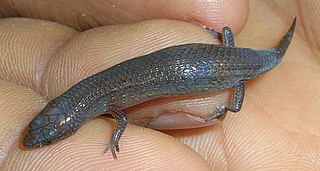Colonel Richard Henry Beddome was a British military officer and naturalist in India, who became chief conservator of the Madras Forest Department. In the mid-19th century, he extensively surveyed several remote and then-unexplored hill ranges in Sri Lanka and south India, including those in the Eastern Ghats such as Yelandur, Kollegal, Shevaroy Hills, Yelagiri, Nallamala Hills, Visakhapatnam hills, and the Western Ghats such as Nilgiri hills, Anaimalai hills, Agasthyamalai Hills and Kudremukh. He described many species of plants, amphibians, and reptiles from southern India and Sri Lanka, and several species from this region described by others bear his name.

Agasthyagama beddomii, commonly known as the Indian kangaroo lizard, is a diurnal, terrestrial, insectivorous agamid lizard, endemic to the Western Ghats of South India.

The Indian golden gecko or Beddome's golden gecko is a species of gecko endemic to the Eastern Ghats of India. It was rediscovered from the hills near present-day Tirupati. The rediscovery was after over 100 years since its description.

Uropeltis pulneyensis, commonly known as the Indian earth snake and the Palni shieldtail, is a species of snake in the family Uropeltidae. The species is endemic to the Western Ghats of India.
The Haly's tree skink is a species of lizard in the family Scincidae. The species is native to Sri Lanka. Earlier thought to be found also in the Western Ghats, taxonomic studies have shown D. haliana to be a Sri Lankan endemic, differentiated from the Indian D. subcaeruleum. D. haliana is the only arboreal skink in Sri Lanka.
Eutropis beddomei, commonly known as Beddome's mabuya or Beddome's skink, is a species of lizard in the family Scincidae. The species is native to India and Sri Lanka.

The bronze grass skink, bronze mabuya or speckled forest skink, is a species of skink found in South and Southeast Asia. It is a common, but shy, ground-dwelling species that is active both day and night.

Eutropis multifasciata, commonly known as the East Indian brown mabuya, many-lined sun skink, many-striped skink, common sun skink or (ambiguously) as golden skink, is a species of skink.

Eutropis rugifera, variously known as Nicobar Island skink or rough-scaled sun skink, is a species of skink from southeastern Asia.
Ristella beddomii, commonly known as Beddome's cat skink and Beddome's ristella, is a species of skink, a lizard in the family Scincidae. The species is native to southwestern India.
Ristella guentheri, commonly known as Günther's ristella and Gunther's cat skink, is a species of lizard in the family Scincidae. The species is endemic to India.

Ristella rurkii, commonly known as Rurk's ristella, is a species of skink endemic to the Western Ghats of southern India. It is a small, insectivorous, diurnal skink found in shola grasslands and rainforests of hills ranges in parts of Tamil Nadu and Kerala states of India.

Ristella travancorica, commonly known as the Travancore cat skink or the Travancore ristella, is a species of skink endemic to the Western Ghats in India.

Kaestlea travancorica, also known as the Travancore ground skink or Barbour's ground skink, is a species of skink endemic to southern Western Ghats.

Indirana beddomii, Beddome's leaping frog, Beddome's Indian frog, or simply Beddome's frog, is a species of frog found in the Western Ghats. They are usually detected by their long leaps as they flush from the ground when disturbed. The species is named after the naturalist Richard Henry Beddome.

Chioninia is a genus of skinks, lizards in the subfamily Lygosominae. For long, this genus was included in the "wastebin taxon" Mabuya. The genus Chioninia contains the Cape Verde mabuyas.

Kaestlea is a genus of skinks. These skinks are small, shiny, smooth-scaled species. They are diurnal, terrestrial and insectivorous. They lay eggs to reproduce. These skinks are identified by their distinct blue tail colour. They live in tropical rainforest and montane forest habitats. These secretive skinks silently move through thick leaf-litter on forest floor. They are all endemic to the Western Ghats mountains and in some parts of Eastern Ghats (Shevaroys) of South India.
Kaestlea beddomii, also known commonly as Beddome's ground skink, is a species of lizard in the family Scincidae. The species is endemic to the Western Ghats of India.













